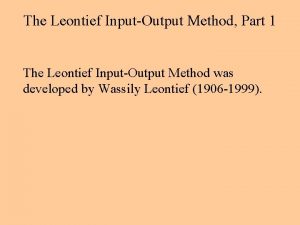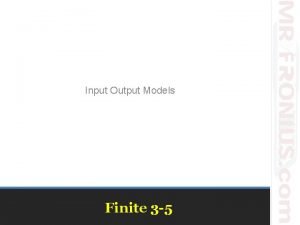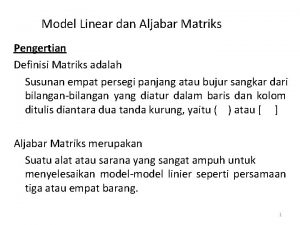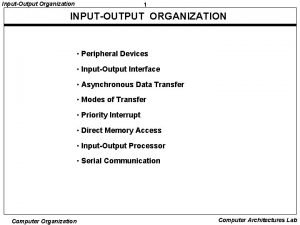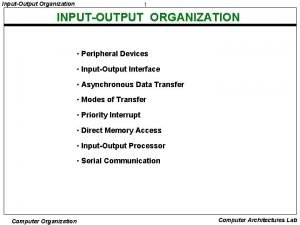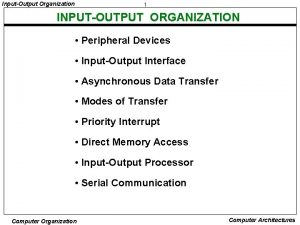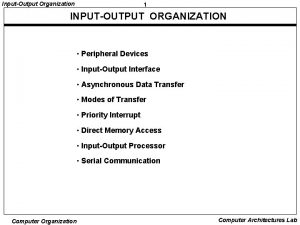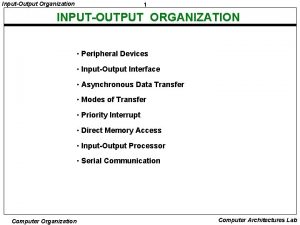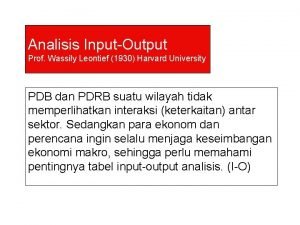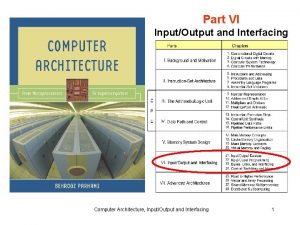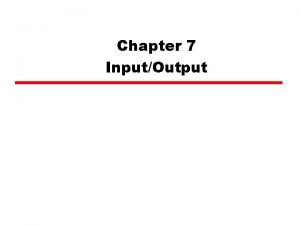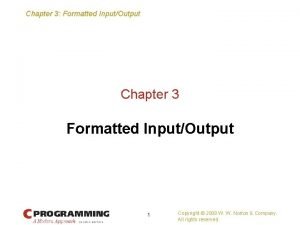The Leontief InputOutput Method Part 2 Example 1
























- Slides: 24

The Leontief Input-Output Method, Part 2 Example 1: Sunny Summer Beverages produces and bottles a variety of fruit juices. For every dollar worth of juice it produces, it keeps $. 04 worth of juice in house to help keep the workers hydrated and happy. If the company produces $200 worth of juice, how much will be available for sale?

The Leontief Input-Output Method, Part 2 Example 1: Sunny Summer Beverages Recall that we can calculate the Demand if we know the Production and the Consumption (. 04 in this case): P: Total Production P -. 04 P = D D: Demand. 96 P = D. 96(200) = $192 = D

The Leontief Input-Output Method, Part 2 We can modify this equation slightly to determine the Demand for a 2 -sector economy. In this case, we’ll use the consumption matrix, C: P – CP = D

The Leontief Input-Output Method, Part 2 Example 2: ABC Furniture manufactures a variety of office furniture. It also manufactures bolts, some of which are used in its furniture. Every dollar worth of bolts produced requires an input of $. 03 worth of bolts and $. 02 worth of office furniture. Each dollar worth of office furniture requires an input of $. 04 worth of bolts and $. 05 worth of office furniture.

The Leontief Input-Output Method, Part 2 Example 2: Recall our weighted digraph, as well as our consumption matrix: . 04. 05 . 03 B . 02 F B From B F To F

The Leontief Input-Output Method, Part 2 Example 2: Suppose the company produces $300 of bolts and $400 of office furniture. How much of each will be available for sale?

The Leontief Input-Output Method, Part 2 Example 2: Suppose the company produces $300 of bolts and $400 of office furniture. How much of each will be available for sale? P – CP = D - =

The Leontief Input-Output Method, Part 2 Example 2: Suppose the company produces $300 of bolts and $400 of office furniture. How much of each will be available for sale? P – CP = D - = So $275 of bolts and $374 of office furniture available to sell.

The Leontief Input-Output Method, Part 2 Things get a little more interesting if we know the demand need to determine the production. Start with our previous equation: P – CP = D

The Leontief Input-Output Method, Part 2 P – CP = D We would like to factor out P on the left hand side of the equation, but it’s not quite as easy with a matrix as it is with a variable. First, we have to multiply P by the Identity matrix, I.

The Leontief Input-Output Method, Part 2 P – CP = D IP – CP = D

The Leontief Input-Output Method, Part 2 P – CP = D IP – CP = D What is an Identity matrix? It assigns a coefficient of 1 to each variable. Then if you multiply I by any matrix, it returns the original matrix: IP = P

The Leontief Input-Output Method, Part 2 P – CP = D IP – CP = D An Identity matrix is always a square matrix (2 x 2, 3 x 3, 4 x 4, etc. ). The diagonal starting in the 1 st row, 1 st column contains 1 s, with all other entries being 0 s.

The Leontief Input-Output Method, Part 2 P – CP = D IP – CP = D Because most of our examples will involve two sectors, I will normally be 2 x 2:

The Leontief Input-Output Method, Part 2 P – CP = D IP – CP = D Now we can factor out P: (I – C)P = D

The Leontief Input-Output Method, Part 2 P – CP = D IP – CP = D (I – C)P = D If (I – C) represented variables, we could simply divide each side of the equation by (I – C) and be done. Because it is a matrix, however, we must multiply by the inverse matrix, (I – C)-1

The Leontief Input-Output Method, Part 2 P – CP = D IP – CP = D (I – C)-1(I – C)P = (I – C)-1 D

The Leontief Input-Output Method, Part 2 P – CP = D IP – CP = D (I – C)-1(I – C)P = (I – C)-1 D Fortunately, (I – C)-1 and (I – C) are inverses, so when we multiply them, they essentially eliminate each other.

The Leontief Input-Output Method, Part 2 P – CP = D IP – CP = D (I – C)-1(I – C)P = (I – C)-1 D We finally get the equation we really want: P = (I – C)-1 D

The Leontief Input-Output Method, Part 2 Example 3: If ABC Furniture receives an order for $200 of bolts and $700 of office furniture, how much of each must it produce to fill the order?

The Leontief Input-Output Method, Part 2 Example 3: If ABC Furniture receives an order for $200 of bolts and $700 of office furniture, how much of each must it produce to fill the order? We are trying to find the production, P, in a two-sector economy, so we will use P = (I – C)-1 D

The Leontief Input-Output Method, Part 2 Example 3: If ABC Furniture receives an order for $200 of bolts and $700 of office furniture, how much of each must it produce to fill the order? P = (I – C)-1 D I= C= because of the two sectors. D=

The Leontief Input-Output Method, Part 2 Example 3: If ABC Furniture receives an order for $200 of bolts and $700 of office furniture, how much of each must it produce to fill the order? P = (I – C)-1 D = ( = ) -1

The Leontief Input-Output Method, Part 2 Example 3: If ABC Furniture receives an order for $200 of bolts and $700 of office furniture, how much of each must it produce to fill the order? P = (I – C)-1 D = So the company must produce $236. 78 worth of bolts and $741. 83 worth of office furniture.
 Inputoutput devices
Inputoutput devices Leontief method
Leontief method Paradoxo de leontief
Paradoxo de leontief The leontief paradox
The leontief paradox The leontief paradox
The leontief paradox Theory absolute advantage
Theory absolute advantage Heckscher ohlin theory
Heckscher ohlin theory Leontief paradox theory
Leontief paradox theory Leontief production equation calculator
Leontief production equation calculator Closed leontief model
Closed leontief model Faktör donatımı teorisi
Faktör donatımı teorisi Leontief teoremi
Leontief teoremi Rybczynski teoremi
Rybczynski teoremi Pengertian notasi matriks
Pengertian notasi matriks Hitunglah koefisien masukan dan keluaran setiap sektor
Hitunglah koefisien masukan dan keluaran setiap sektor định lý stolper-samuelson
định lý stolper-samuelson Economia internazionale krugman riassunto
Economia internazionale krugman riassunto Technical description
Technical description Advantages of symposium
Advantages of symposium Hình ảnh bộ gõ cơ thể búng tay
Hình ảnh bộ gõ cơ thể búng tay Slidetodoc
Slidetodoc Bổ thể
Bổ thể Tỉ lệ cơ thể trẻ em
Tỉ lệ cơ thể trẻ em Voi kéo gỗ như thế nào
Voi kéo gỗ như thế nào Chụp phim tư thế worms-breton
Chụp phim tư thế worms-breton

